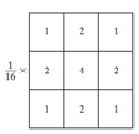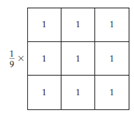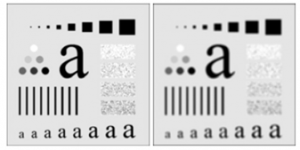This set of Digital Image Processing Multiple Choice Questions & Answers (MCQs) focuses on “Smoothing Spatial Filters”.
1. Noise reduction is obtained by blurring the image using smoothing filter.
a) True
b) False
View Answer
Explanation: Noise reduction is obtained by blurring the image using smoothing filter. Blurring is used in pre-processing steps, such as removal of small details from an image prior to object extraction and, bridging of small gaps in lines or curves.
2. What is the output of a smoothing, linear spatial filter?
a) Median of pixels
b) Maximum of pixels
c) Minimum of pixels
d) Average of pixels
View Answer
Explanation: The output or response of a smoothing, linear spatial filter is simply the average of the pixels contained in the neighbourhood of the filter mask.
3. Smoothing linear filter is also known as median filter.
a) True
b) False
View Answer
Explanation: Since the smoothing spatial filter performs the average of the pixels, it is also called as averaging filter.
4. Which of the following in an image can be removed by using smoothing filter?
a) Smooth transitions of gray levels
b) Smooth transitions of brightness levels
c) Sharp transitions of gray levels
d) Sharp transitions of brightness levels
View Answer
Explanation: Smoothing filter replaces the value of every pixel in an image by the average value of the gray levels. So, this helps in removing the sharp transitions in the gray levels between the pixels. This is done because, random noise typically consists of sharp transitions in gray levels.
5. Which of the following is the disadvantage of using smoothing filter?
a) Blur edges
b) Blur inner pixels
c) Remove sharp transitions
d) Sharp edges
View Answer
Explanation: Edges, which almost always are desirable features of an image, also are characterized by sharp transitions in gray level. So, averaging filters have an undesirable side effect that they blur these edges.
6. Smoothing spatial filters doesn’t smooth the false contours.
a) True
b) False
View Answer
Explanation: One of the application of smoothing spatial filters is that, they help in smoothing the false contours that result from using an insufficient number of gray levels.
7. The mask shown in the figure below belongs to which type of filter?

a) Sharpening spatial filter
b) Median filter
c) Sharpening frequency filter
d) Smoothing spatial filter
View Answer
Explanation: This is a smoothing spatial filter. This mask yields a so called weighted average, which means that different pixels are multiplied with different coefficient values. This helps in giving much importance to the some pixels at the expense of others.
8. The mask shown in the figure below belongs to which type of filter?

a) Sharpening spatial filter
b) Median filter
c) Smoothing spatial filter
d) Sharpening frequency filter
View Answer
Explanation: The mask shown in the figure represents a 3×3 smoothing filter. Use of this filter yields the standard average of the pixels under the mask.
9. Box filter is a type of smoothing filter.
a) True
b) False
View Answer
Explanation: A spatial averaging filter or spatial smoothening filter in which all the coefficients are equal is also called as box filter.
10. If the size of the averaging filter used to smooth the original image to first image is 9, then what would be the size of the averaging filter used in smoothing the same original picture to second in second image?

a) 3
b) 5
c) 9
d) 15
View Answer
Explanation: We know that, as the size of the filter used in smoothening the original image that is averaging filter increases then the blurring of the image. Since the second image is more blurred than the first image, the window size should be more than 9.
11. Which of the following comes under the application of image blurring?
a) Object detection
b) Gross representation
c) Object motion
d) Image segmentation
View Answer
Explanation: An important application of spatial averaging is to blur an image for the purpose of getting a gross representation of interested objects, such that the intensity of the small objects blends with the background and large objects become easy to detect.c
12. Which of the following filters response is based on ranking of pixels?
a) Nonlinear smoothing filters
b) Linear smoothing filters
c) Sharpening filters
d) Geometric mean filter
View Answer
Explanation: Order static filters are nonlinear smoothing spatial filters whose response is based on the ordering or ranking the pixels contained in the image area encompassed by the filter, and then replacing the value of the central pixel with the value determined by the ranking result.
13. Median filter belongs to which category of filters?
a) Linear spatial filter
b) Frequency domain filter
c) Order static filter
d) Sharpening filter
View Answer
Explanation: The median filter belongs to order static filters, which, as the name implies, replaces the value of the pixel by the median of the gray levels that are present in the neighbourhood of the pixels.
14. Median filters are effective in the presence of impulse noise.
a) True
b) False
View Answer
Explanation: Median filters are used to remove impulse noises, also called as salt-and-pepper noise because of its appearance as white and black dots in the image.
15. What is the maximum area of the cluster that can be eliminated by using an n×n median filter?
a) n2
b) n2/2
c) 2*n2
d) n
View Answer
Explanation: Isolated clusters of pixels that are light or dark with respect to their neighbours, and whose area is less than n2/2, i.e., half the area of the filter, can be eliminated by using an n×n median filter.
Sanfoundry Global Education & Learning Series – Digital Image Processing.
To practice all areas of Digital Image Processing, here is complete set of 1000+ Multiple Choice Questions and Answers.
If you find a mistake in question / option / answer, kindly take a screenshot and email to [email protected]
- Apply for Electronics Engineering Internship
- Practice Electrical Engineering MCQs
- Check Electronics Engineering Books
- Apply for Electrical Engineering Internship
- Practice Electronics Engineering MCQs
